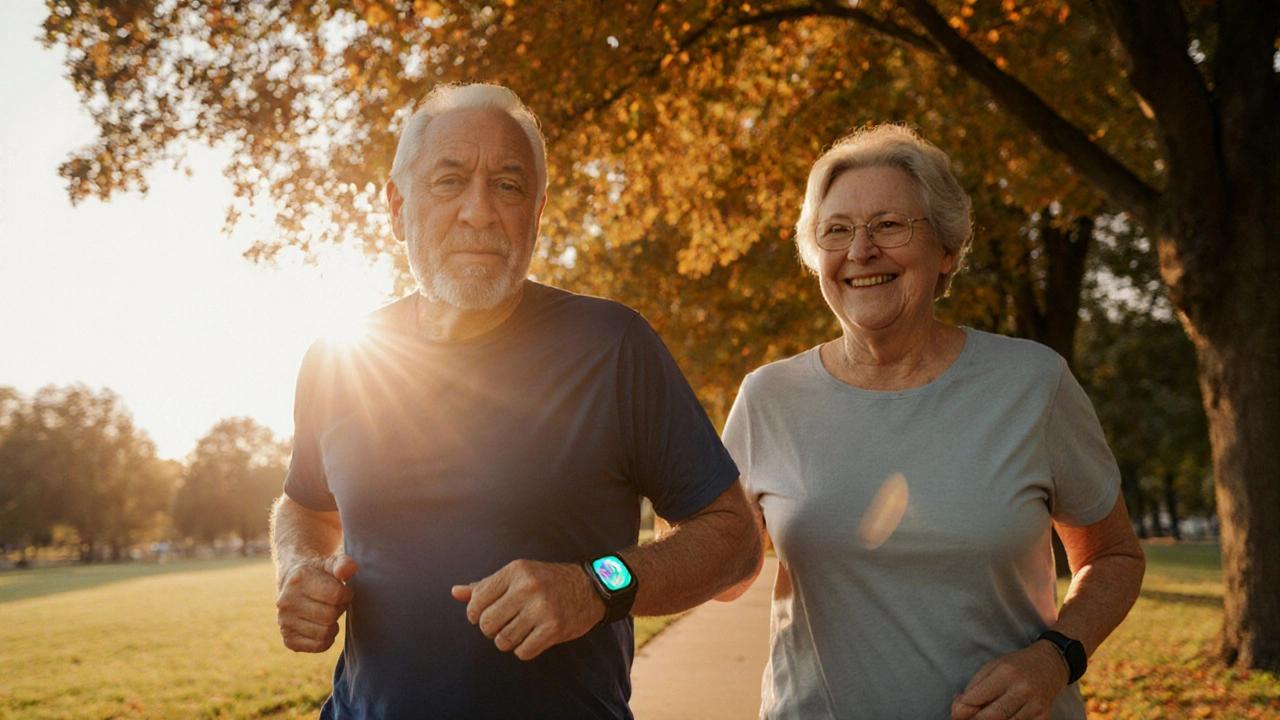When dealing with intermittent claudication is a symptom of peripheral artery disease that causes painful leg cramping during walking, staying motivated can feel impossible. The good news is that the right mix of mindset tricks, simple habits, and professional support can turn a frustrating regimen into a steady path toward pain‑free steps.
Quick Takeaways
- Set a realistic, measurable walking goal (e.g., add 30 seconds each session).
- Use a log or app to track pain, distance, and mood.
- Pair each walk with a pleasant cue - a podcast, favorite playlist, or scenic route.
- Schedule regular check‑ins with a vascular surgeon or physical therapist to tweak the plan.
- Address the three biggest roadblocks: pain fear, boredom, and lifestyle habits.
Understanding Intermittent Claudication
First, let’s demystify the condition. Peripheral artery disease (PAD) narrows the arteries that supply the legs. When the muscles don’t get enough oxygen during activity, they scream - that’s the cramp you feel after a few minutes of walking. The pain typically disappears after a short rest, which can lead many patients to avoid exercise altogether, creating a vicious cycle of reduced circulation and worsening symptoms.
Doctors assess severity with the ankle‑brachial index (ABI). An ABI below 0.90 usually signals PAD; the lower the number, the higher the risk of cardiovascular events. Knowing your ABI gives you a concrete baseline to watch for improvement.
Why Motivation Matters in Treatment
Research shows that supervised exercise therapy (SET) can improve walking distance by 150‑200 meters on average. But the benefit only shows up if you stick with the program for at least 12 weeks. That’s why motivation isn’t a nice‑to‑have; it’s a treatment component.
Motivation fuels consistency, which drives the physiological adaptations your blood vessels need: collateral vessel growth, improved endothelial function, and lower blood pressure. In short, every motivated step you take is a step toward a healthier circulatory system.
Core Pillars of Intermittent Claudication Treatment
Successful management typically combines five pillars:
- Walking program: Structured, symptom‑limited walking sessions performed 3‑5 times per week.
- Medication: Cilostazol (if tolerated) can increase walking distance by up to 30%.
- Lifestyle changes: Smoking cessation, heart‑healthy diet, and weight control.
- Risk factor control: Managing cholesterol, blood pressure, and diabetes.
- Regular follow‑up: ABI checks, symptom review, and plan adjustments.
Each pillar has its own motivation challenges, which we’ll tackle one by one.
Daily Motivation Techniques
Below are practical tricks you can start using today.
1. Anchor Walks to a Reward
Pair each walk with something you genuinely enjoy - a new episode of a true‑crime podcast, a coffee from a favorite café, or a 5‑minute stretch session afterward. The brain learns to associate the effort with a pleasant outcome, making it easier to start.
2. Break It Down
Instead of aiming for a 30‑minute walk right away, set micro‑goals: 5 minutes, rest, then another 5. Add 30 seconds to the next session. Over weeks, those tiny increments compound into big gains.
3. Visual Progress Tracker
Use a simple spreadsheet or a free app to log:
- Date and time
- Distance covered (or minutes walked)
- Pain level (0‑10 scale)
- Mood rating
Seeing a steady trend of “pain rating down, distance up” builds confidence faster than vague recollection.
4. Social Accountability
Invite a friend or join a local PAD support group. Even a weekly text check‑in makes you less likely to skip a session.
5. Mindful Breathing During Walks
Focus on a 4‑2‑4 breathing pattern (inhale 4 seconds, hold 2, exhale 4). It reduces perceived exertion and helps you stay within your pain threshold without over‑pushing.
6. Celebrate Milestones
When you add 5 minutes to your total walking time or notice a lower ABI, treat yourself - a new book, a movie night, or a short weekend getaway. Celebrate the health win, not just the activity.
Tracking Progress and Adjusting the Plan
Motivation can dip when results stall. That’s why objective data matters.
Every 4‑6 weeks, revisit your ABI and compare it to baseline. If the index improves by 0.05 or more, you’ve made measurable progress. If it stays flat, consider tweaking one pillar:
- Increase walking intensity slightly (add a slight incline).
- Discuss medication dosage adjustments with your physician.
- Add a short session of resistance training to boost leg strength.
Document each change in your tracker; it creates a feedback loop that reinforces the “I’m improving” narrative.
Dealing with Setbacks
Life throws curveballs - flu, job stress, or a bad weather day. Here’s a quick reset plan:
- Accept the pause - don’t beat yourself up.
- Schedule a catch‑up walk within the next 48hours (even 10 minutes counts).
- Adjust your goal for the week: if you missed two sessions, add a 5‑minute buffer to the remaining days.
- Use the setback as data: Did pain increase? Did you skip medication? Identify the cause.
Remember, consistency over months outweighs perfection each single week.
Professional Support: Who to Involve
While you can self‑manage many aspects, a multidisciplinary team keeps you on track.
- Vascular surgeon: Evaluates disease severity, orders ABI tests, and decides if revascularization is needed.
- Physical therapist: Designs the walking program, monitors gait, and adjusts intensity safely.
- Cardiologist: Manages heart‑related risk factors and medication interactions.
- Primary care physician: Tracks overall health, labs, and lifestyle counseling.
- Smoking cessation counselor (if you smoke): Provides nicotine replacement options and behavioral strategies.
Schedule a brief 15‑minute check‑in every 2-3 months. The routine reminder is itself a motivation boost.
Motivation Checklist (Printable)
| Task | Done? | Notes |
|---|---|---|
| Log walk (time, distance, pain level) | ||
| Practice 4‑2‑4 breathing | ||
| Reward yourself (podcast, coffee, stretch) | ||
| Check medication (Cilostazol, blood pressure) | ||
| Send a quick update to accountability partner |
Print this table, stick it on your fridge, and tick off each item. Small wins add up.
Frequently Asked Questions
How quickly can I expect to see improvement?
Most patients notice a 10‑20% increase in walking distance after 6-8 weeks of consistent supervised exercise therapy, especially when paired with medication and lifestyle changes.
Is walking the only exercise I can do?
Walking is the cornerstone, but low‑impact activities like stationary cycling or water aerobics can supplement your routine without over‑loading the calves.
Can I skip medication if I stick to the walking plan?
Medication like cilostazol works best alongside exercise. Talk to your doctor before stopping any drug, even if you feel better.
What if I experience sharp pain during a walk?
Sharp or burning pain that doesn’t subside after stopping may signal a more serious issue. Stop, rest, and contact your healthcare provider promptly.
How does smoking affect my treatment?
Smoking accelerates arterial narrowing and can blunt the benefits of exercise. Quitting can improve walking distance by up to 30% within a few months.
Staying motivated isn’t a one‑size‑fits‑all recipe, but the blend of clear goals, data‑driven tracking, and supportive habits turns a painful symptom into a manageable part of your day. Keep the focus on small, repeatable actions, and watch your confidence grow as quickly as your steps.







Hayden Kuhtze
September 28, 2025Oh, you apparently think a few minutes of walking is comparable to scaling Everest, so let me kindly clarify the basics.